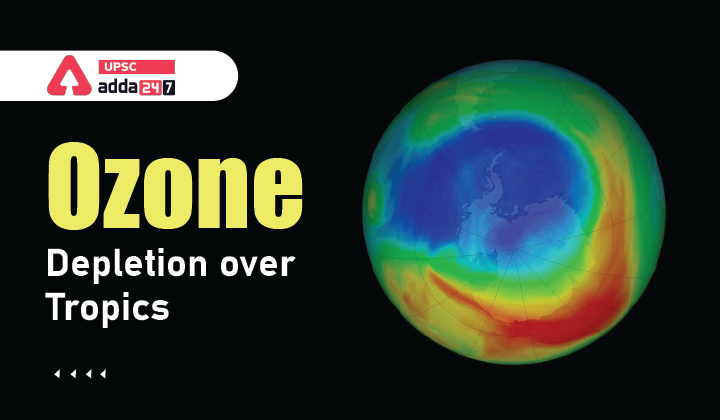Table of Contents
Ozone depletion UPSC: Relevance
- GS 3: Conservation, environmental pollution and degradation, environmental impact assessment.
Ozone depletion: Context
- Recently, scientists have revealed a large, all-season ozone hole in the lower stratosphere over the tropics thus causing a great global concern.
Ozone depletion over tropics: Key points
- The ozone hole over the tropics is comparable in depth to that of the well-known springtime Antarctic hole, but roughly seven times greater in area.
- The observed data agree with the cosmic-ray-driven electron reaction (CRE) model and strongly indicate the identical physical mechanism working for both Antarctic and tropical ozone holes.
- All-season ozone hole is defined as an area of ozone loss larger than 25% compared with the undisturbed atmosphere.
- The observation comes as a surprise to many scientists as it was not predicted by conventional photochemical models.
- In the polar ozone hole, approximately 80% of the normal ozone value is found to be depleted at the center of the tropical ozone hole.
Ozone Depletion over Tropics: Why concern?
- The tropics constitute half the planet’s surface area and are home to about half the world’s population.
- Preliminary reports show ozone depletion levels over equatorial regions are already endangering large populations and the associated UV radiation reaching these regions is far greater than expected.
- The present discovery calls for further careful studies of ozone depletion, UV radiation change, increased cancer risks, and other negative effects on health and ecosystems in the tropical regions
Ozone Depletion over Tropics: Impact
- The depletion of the ozone layer can lead to increased ground-level UV radiation, which can increase risk of skin cancer and cataracts in humans.
- It can also weaken human immune systems, decrease agricultural productivity, and negatively affect sensitive aquatic organisms and ecosystems.
What is ozone layer?
- Ozone layer meaning: The Ozone layer is present in Earth’s atmosphere (15-35km above Earth) in the lower portion of the stratosphere and has relatively high concentrations of ozone (O3). It reduces harmful UV radiation reaching the Earth’s surface.
What is ozone layer depletion?
- Ozone layer depletion is the gradual thinning of the earth’s ozone layer present in the upper atmosphere.
- Ozone depletion also consists of a much larger springtime decrease in stratospheric ozone around Earth’s polar regions, which is referred to as the ozone hole.
Ozone depletion causes
- Manufactured chemicals, especially manufactured halocarbon refrigerants, solvents, propellants, and foam- blowing agents (chlorofluorocarbons (CFCs), HCFCs, halons) are the major causes of ozone layer depletion.
- Since the early 1970’s, scientists observed reduction in stratospheric ozone and it was found more prominent in Polar Regions.
- Ozone Depleting Substances have a lifetime of about 100 years.
Read current affairs for UPSC





 TSPSC Group 1 Question Paper 2024, Downl...
TSPSC Group 1 Question Paper 2024, Downl...
 TSPSC Group 1 Answer key 2024 Out, Downl...
TSPSC Group 1 Answer key 2024 Out, Downl...
 UPSC Prelims 2024 Question Paper, Downlo...
UPSC Prelims 2024 Question Paper, Downlo...





